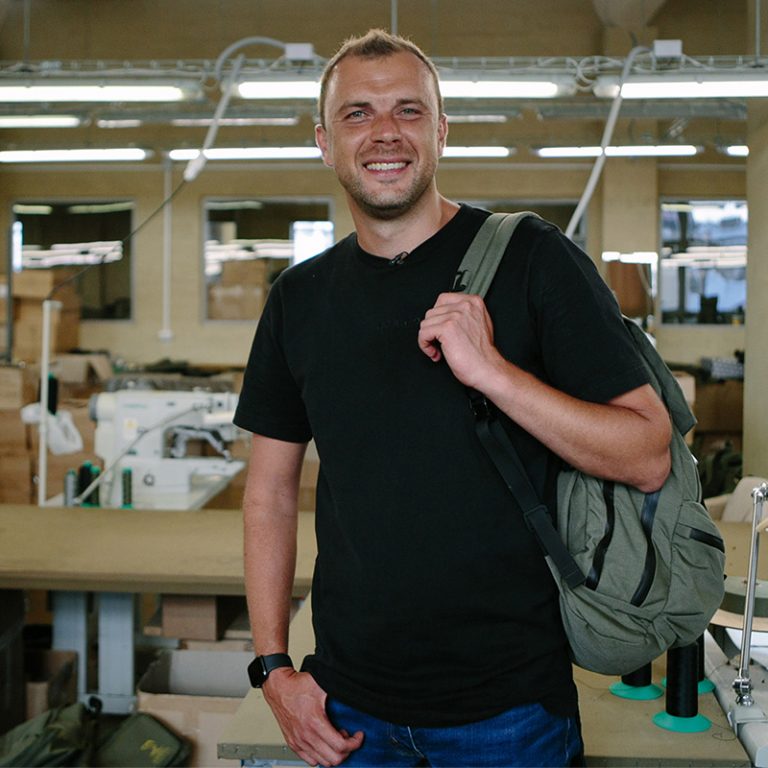A desire to create a high-quality and worldwide recognizable product pushed Oleh Vlasenko to found the Ukrainian backpack brand Huru in 2014. Their first backpack crowdfunding campaign on Kickstarter had an overwhelming success: they raised three times more money than had been initially required. Today Huru exports to over 50 countries worldwide, competing with American and Scandinavian backpacks.
The idea of starting a backpack brand came to Oleh Vlasenko in 2017. Trained as a surgeon, he used to work for a medical company at that time. While on a business trip abroad, Oleh got caught in the rain, and his backpack with his documents were completely soaked. Then, he made it a goal to create a high-quality backpack that would appeal to him first of all.
Oleh started devising a design by researching backpack models that had been already available on the market:
“In the USA I bought a few examples of backpacks, which I liked. But I still couldn’t get the hang of how their functionality works, I would lose my stuff in their compartments. Then I took those backpacks to Kyiv and here’s how it all began.”
Once usability and functionality were decided as priorities, Oleh developed a vision of the desired backpack. And yet he lacked a team to implement the idea.

Start and team
Oleh and Vitalii Bychenko, a prospective designer, were introduced by mutual friends. Vitalii used to make only clothes before that, so he rose to thechallenge of designing backpacks.
“Oleh dreamt of creating backpacks. I had never dealt with backpacks before. So we met, got acquainted and Oleh asked me ‘Will you do it?’, and I answered, ‘I’ll give it a try’.”
It took three months to devise the first model. The team was focusing on backpacks from the USA and Scandinavia: while identifying disadvantages of foreign backpacks, they were trying to improve the functionality. Thus, the first backpack, H1, was created and its buckle featured the letter H, the logo of a newly-created brand Huru. The brand name translates as “liberty” from the Swahili language.
“There is no word HURU written on our backpacks at all, they feature only the logo since one of our brand concepts is that a person or a user is actually a brand, but not what they wear. Our brand has to complete the human silhouette.”

Our team entered Kickstarter, a crowdfunding platform for creative projects all over the world, with the H1 model. Our primary goal was not to raise money, but to announce the brand: the team cooperated actively with American and European media so that before launching H1, the brand was known on the foreign market.
Establishing production processes, setting up ads on social media, publishing product reviews by interested journalists and bloggers, was part of an intensive preparation that lasted about six months. The team sent the H1 model to journalists which resulted in 20 independently published reviews.
“Some (reviewers) were so mad about our backpack that they made videos and some wrote longreads with photos and reviews. And it is those articles and media that helped us to find our first Kickstarter backers who bought our backpacks and created the client pool.”
Backers
Eng. backers — people who give financial support to the project.Finally, in 2017 the Huru campaign on Kickstarter exceeded all of our expectations: the team raised three times more money than was needed within two days. This marked the beginning of rapid brand development. That was also a valuable business experience, which Oleh shared with people at public lectures and workshops.
Here’s some advice (how to launch a successful crowdfunding campaign — ed.): prepare for Kickstarter, understand the whole process from designing to manufacturing, passion the product, and commitment to your buyers.
After succeeding on Kickstarter, the team went on manufacturing H1 and started to design another model and create its own website. The new model, H2, was also promoted on Kickstarter, but this time the campaign failed due to lack of communication with the audience.
The failure made the team revise their marketing strategy, thus Huru started their own PR department shortly afterwards.

In 2020 Maksym Lukasevych, who had helped choose materials for the first backpack in 2017, joined the team. After becoming a co-owner of the company, Maksym became responsible for the technical aspects of the process: logistics, shipping to clients, manufacturing and supply of raw materials, and quality control. It was he who set up production in Lviv. But before that, they could not find a technologically suitable factory in Ukraine, therefore some elements of backpack hardware were manufactured in Germany and Poland.
The production of our backpacks requires elaborate sewing machines with very sharp needles for extra heavy fabrics that can bear the load of strong thread and a massive amount of cloth. That is why we were looking for a factory that would be able to carry out such work and, first of all, would specialize in backpacks and bags. We found out that there were such factories in Lviv. In my opinion, it is one of Ukrainian cities that specializes in the garment industry.
Today Huru employs twenty people. Close attention to manufacturing and material selection helps to achieve the key goal — to create a product of the highest quality with few or no defects. The team makes all production decisions together.
In autumn 2020 Taras Voitiuk, the commercial manager, joined the team. His responsibilities include selling, communicating, developing new offline stores, and upgrading the website.
“When you make a decision to join a team, you have to fall in love with the product or it has to be immensely enjoyable for you. As a member of the team, I popularize our backpack as much as possible via social media, through friends, and by using it every day.”

Oksana, the chief designer, also works at the factory. Her responsibilities include monitoring the technical aspect of backpack manufacturing, eliminating production defects, preparing models for sewing as well as helping with developing and testing new models.
The core team has now been formed. As for Oleh Vlasenko, the greatest advantage of developing the company in Ukraine is working with people who you see eye to eye with.
“I have invited people to join the team and I want these people to fulfill themselves with me. They feel good working with me and I feel good working with them. And that’s cool, it motivates me a lot. And the second reason why I do it (develop the brand) is that I like what we produce. I like wearing our backpacks, that’s why I will make them.”

Backpacks
The range of Huru backpack models is gradually growing in view of the fact that our designers focus on the quality and uniqueness of each model first of all. H1 is, to date, our unchanging model since Huru made a strong entry into the market with it. Our second model, H2, is a peculiar standard for all Huru backpacks because the team has developed their own recognizable style while devising this very model. There are two more models — backpacks of different capacity and purposes: one is devised for traveling or flights, another is a casual urban backpack that is available in nine colors.
All new models have to pass a specific test: if somebody from the team does not like wearing a test backpack, the design is changed. Oleh says:
“I take the first model, wear it and almost always I don’t like it. Me and Vitalii, our designer, make the second, the third, the fourth model, until we get such a result that would meet both design, quality, and philosophy expectations. Therefore, we release a new model once per year.”
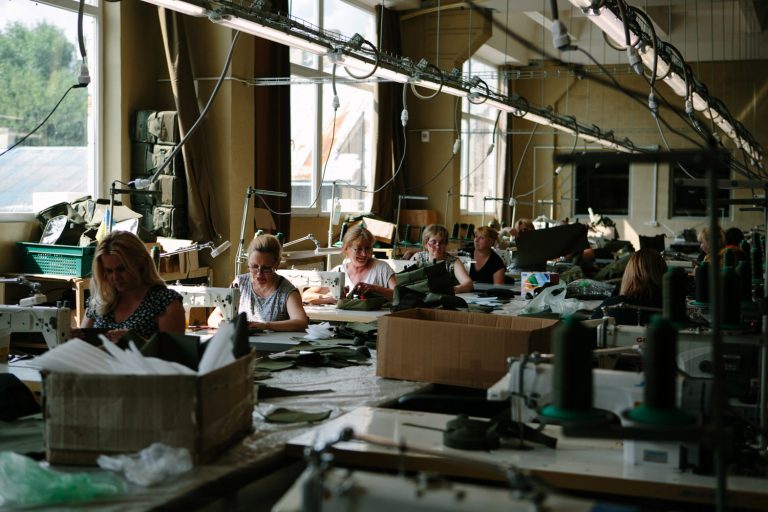
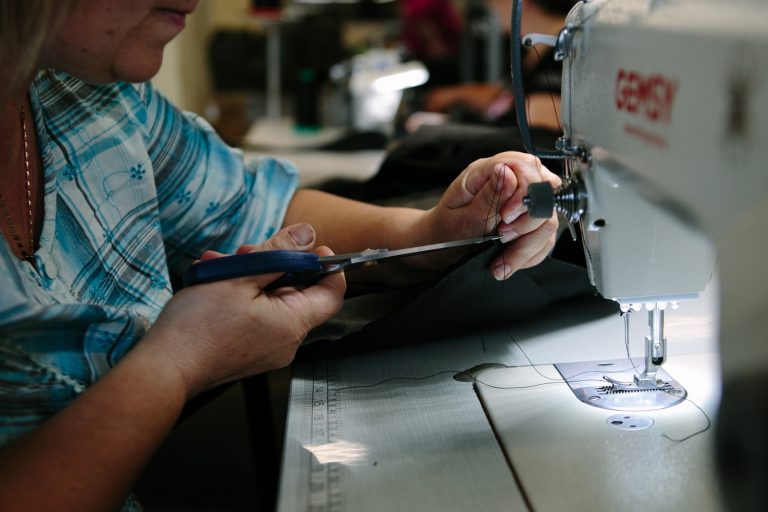
slideshow
The brand team has also created a special accessory — a messenger bag that fulfills two roles: it serves both as a belt and a bag. An empty messenger bag can be attached to a backpack and serve as a belt, but it can also be used as a regular banana bag for strolling when you need to take only the most necessary stuff with you. The same complementary nature characterizes buckles for our backpacks. Considering the fact that this element is extremely durable and quite expensive, the manufacturer decided to make it detachable: if you want, you can take it off one model and attach it to another easily.
Another optimal solution was product standardization: for convenience, the compartments are located identically in all backpacks.
For example, if you always put your keys in the left pocket, then when you take the keys from the left compartment of the backpack, you will always put them into the left compartment of the messenger bag. This is such a meticulous thing, but people who like such uniformity in things appreciate it a lot.

Metal hardware is a feature of the design: hooks, fasteners, clasps, buckles and so on — all this stuff is made with a laser marking machine in Ukraine, thus all the details are not only durable and strong, but they also have an ideal shape, and do not unsew the fabric.
Although the production is based in Ukraine, backpack materials are ordered from abroad: German Cordura, Japanese water repellent zippers, American Velcro. The suppliers were chosen based on the quality of their goods and the reliability of production technologies so that Huru is able to get high-quality goods for years on an ongoing basis.
Huru backpacks are fully guaranteed. Each backpack has its own unique number, which is added to the database: it protects the brand from fakes and makes it possible to send a backpack for guaranteed repair. In addition, the manufacturer emphasizes backpack safety features. Almost every model has secret pockets that can’t be seen due to the black lining of backpacks. All hardware is quite tight and when you open zippers, it makes a specific sound, which prevents pickpockets from having inconspicuous access to compartments. The models are designed so as to maximize product functionality. Vitalii Bychenok, a designer, says:
“An ordinary classic backpack is a kind of sack where you throw all your stuff and then it takes you a long time to find something inside it. Our backpacks have plenty of compartments, so you can arrange everything nicely in order to find what you need quickly and conveniently.”
A painstaking attention to detail and an elaborate design make Huru a special market: for example, there are small pockets for credit cards or keys on the backpack straps, which makes it possible to have instant access to necessary things.
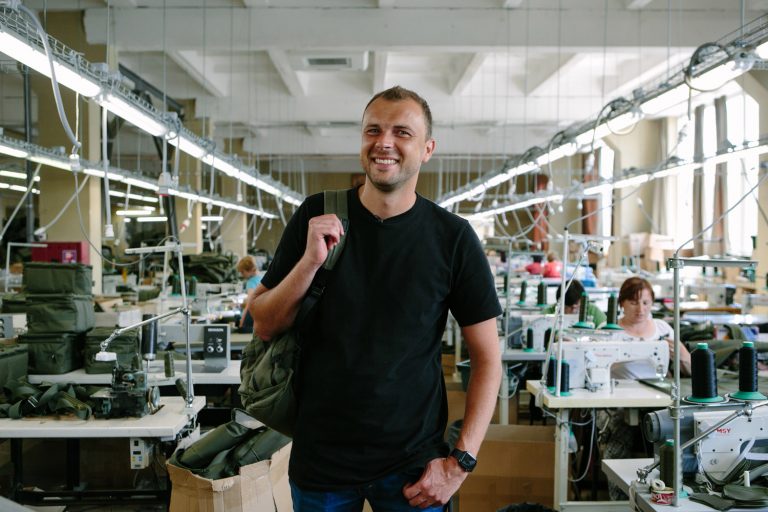
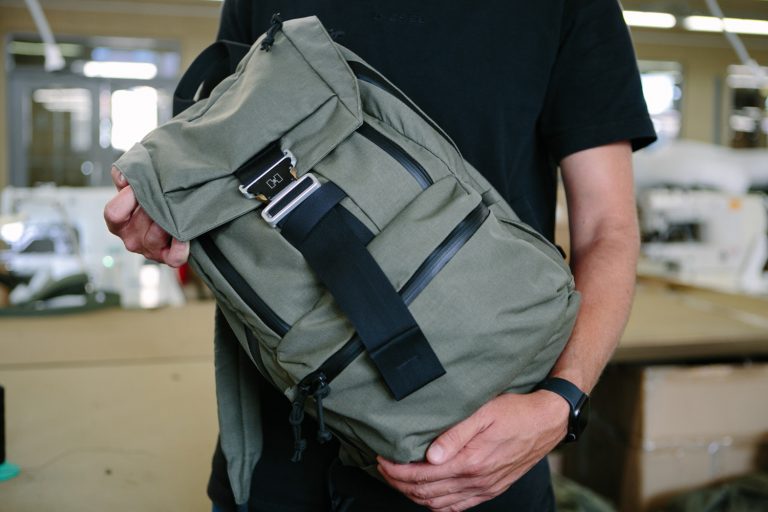
slideshow
Communication via Kickstarter
Huru has also achieved success due to the promotion of its products. Instead of participating in exhibitions or communicating through advertising, the Huru team chose the crowdfunding platform to present a niche backpack:
“Because, in our opinion, Kickstarter was and maybe is one of the best media opportunities for startups. It is about the brand announcement on the market and creating its recognition outside Kickstarter. Thus, there is a good informational basis to write a lot of articles and, finally, this creates the first pull of clients who get your product quickly.”
In spite of the successful experience of promoting the product during the first Kickstarter campaign, the team had no coherent marketing strategy till 2019 and focused primarily on the production process. This approach was changing as the range of models was growing:
We understood that we had to learn to present them (backpacks) in a proper way, sell them, promote them, and so on. We needed the assistance of strong marketing strategists who helped us to develop a viable marketing strategy that involved communication with media, users, and obtaining feedback.
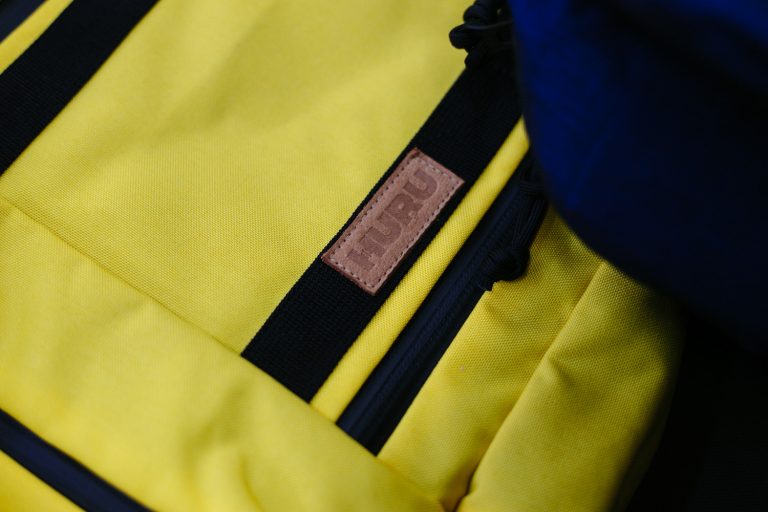
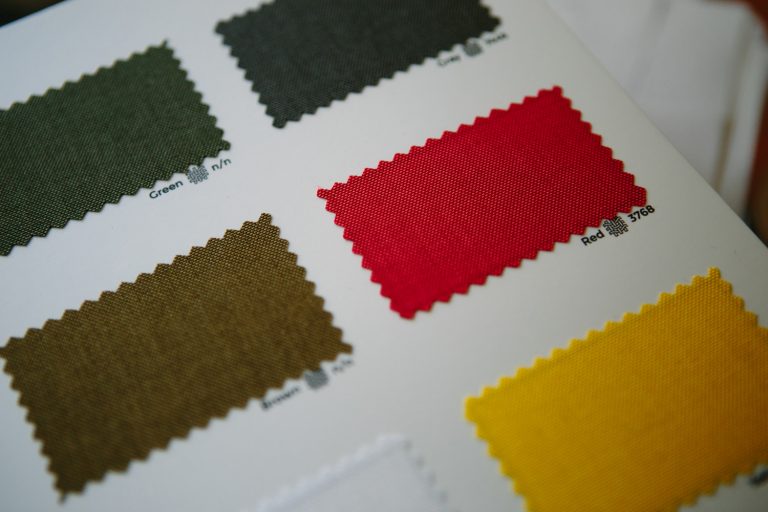
slideshow
After launching the third model, the team started focusing primarily on PR and invested resources into product promotion. They involved SMM, online ads, started working with copywriting agencies, made professional photoshoots and collaborated actively with bloggers.
Another development direction is collaboration with companies who order branded merchandise and goods. For example, Huru worked with KLM airlines: their managers ordered an exclusive batch of H2 backpacks with the airline logo for their crew and top clients. Huru has also worked with IT companies that placed corporate orders. Now the team is preparing mockups of their backpacks and messenger bags with the label that says “Your logo or embroidery here”.
“And PR, as we see it, is a collaboration, cooperation with people who share our ideas and philosophy.”

The way of exporter
Working in a niche market has its own disadvantages: buyers are very familiar with characteristics of competitor products and they refer to similar items. In spite of or due to the H1’s popularity, the backpack was criticized for its resemblance to American competitors whose products were used as references. Nevertheless, our brand has found its own style with the introduction of the H2 model. Vitalii recalls:
“It seems to be distinctive, not resembling any other backpacks. So, our brand can be recognized in the street. And since the second one (backpack — ed.) was released, the business took off: other models, products, and so on.”

The brand started on foreign markets, in particular, the USA, and it is still committed to this strategy. According to the Huru commercial manager, the export strategy is aimed at popularizing the product as made in Ukraine:
“We are creating a global brand that is popular in more than 50 countries worldwide. We work so that the world knows about us as much as possible and consequently knows that these backpacks are made in Ukraine.”
Now Huru exports to over 53 countries worldwide, in particular to Europe, the USA, Japan, Singapore, and Australia. Furthermore, clients from more than 10 countries buy backpacks in batches as corporate orders or via local crowdfunding companies. This strategy is beneficial for everyone: clients get backpacks at a reduced price and the manufacturer gets a large order. Arranging sales under this scheme allowed the brand to penetrate the Japanese market since local people got used to buying via local crowdfunding platforms.

Huru also works with private clients: the brand has a lot of fans from different continents.
“People who buy our backpacks are like one-car brand aficionados. They can buy one model of backpack, then another one, so to say these people become our followers.”
Now, in most cases, trade is conducted online: niche youtube-reviewers are engaged, those who are knowledgeable about tourist equipment and can tell about the backpacks of our company comprehensively and truthfully. Such video reviews are intended to make it easier for prospective customers to choose a backpack because the main focus is on the backpack’s functionality.
“We do not pay for the posts at all, we don’t want to have dishonest reviews. Even if bloggers say that they will write or say everything about us, everything that they think, we ask to do so is because we really want to know what is wrong with them and what people might not like.”

It is through such an approach that the brand builds its public image competing with backpacks from the USA and Scandinavia which gained trust a long time ago. Taras points out that foreigners still don’t know a lot about high-quality Ukrainian products.
“Usually, when we work with some internet bloggers or influencers, they are surprised that the entire production cycle takes place in Ukraine and they are amazed by the (backpack’s — ed.) quality.”
And yet the main goal of the company, for now, is to enter the offline market as that would allow customers to feel all the materials and try a backpack on. When a client opts for a Huru backpack, he usually makes a conscious and sensible decision based on the quality:
“As for functional characteristics, 80% is for the clients’ ratio and only 20% is for their emotions. That is why offline is definitely our way.”
Huru plans not only to enter foreign offline markets, but to develop offline in Ukraine as well: first, the team wants to open their own brand store in Kyiv or Lviv because they have only a tiny space in the Kyiv “Kooperatyv” (Kooperatyv is a Kyiv office space for creative businesses). In addition, they plan to expand their production and make clothes:
“We want to communicate with Ukrainians who share our philosophy and to improve our PR abroad.”
Each new example of a high-quality Huru product, each new satisfied client or favorable review online makes the brand more trustworthy and recognizable all over the world:
“This is not a product that people buy because someone else has the same one. This is a product that people buy in order to use it, to be with it, and to take pleasure in it. That is why the story is definitely about us. Our story is about functionality and quality.”

